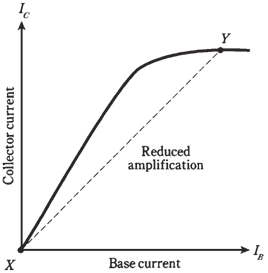Overdrive:
Even when the transistor is biased for best operation, a strong input signal can drive it to point B or beyond it during part of cycle. Then, dIC /dIB is reduced, as shown in Fig. Points X and Y in the graph represent the instantaneous current extremes during the signal cycle.

Figure-- Excessive input reduces amplification.
When conditions are those given in the figure, there will be distortion in the transistor amplifier. Output waveform will not have same shape as the input waveform. This kind of nonlinearity can be tolerated sometimes; sometimes it cannot be.
The more serious trouble with overdrive is the fact that transistor is in or near saturation during the part of cycle. When this occurs, we are getting no bang for buck. The transistor is doing useless work for portion of every wave cycle. This decreases circuit efficiency, makes excessive collector current, and can overheat base collector (B-C) junction. At times overdrive can destroy a transistor.